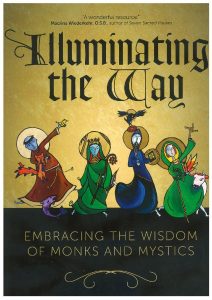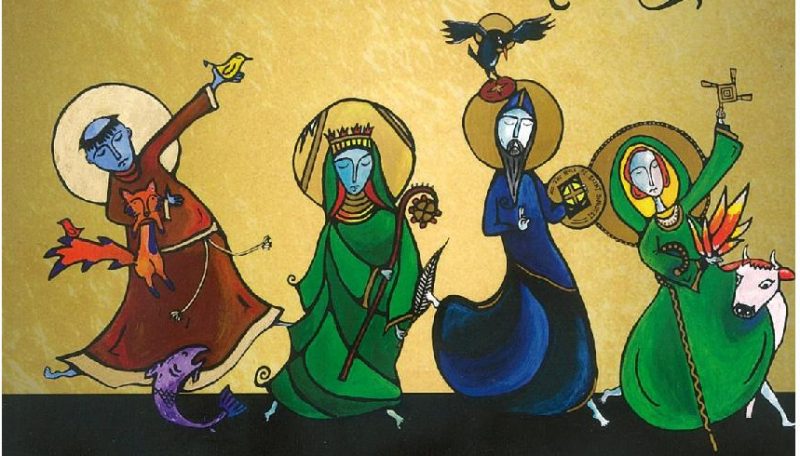ILLUMINATING THE WAY: Embracing the Wisdom of Monks and Mystics, by Christine Valters Paintner (Notre Dame: Sorin Books, 2016). Supplied by Pleroma Christian Supplies $39.99 Reviewed by DANIEL J. STOLLENWERK
 Benedictine Oblate, PhD in Christian Spirituality, online abbess for Abbey of the Arts, and author of nine works on Spirituality, Christine Valters Paintner puts to print in this book a series of online retreats about twelve monks and mystics from the Judeo-Christian tradition.
Benedictine Oblate, PhD in Christian Spirituality, online abbess for Abbey of the Arts, and author of nine works on Spirituality, Christine Valters Paintner puts to print in this book a series of online retreats about twelve monks and mystics from the Judeo-Christian tradition.
In each short chapter the author juxtaposes the spiritual mentor with what psychologist Carl Jung called an archetype. St Francis is the Fool for Christ. King David the Sovereign teaches us to take responsibility for our task in life. Fourth century desert mother Amma Syncletica is the Warrior who battles gluttony, lust, avarice, anger, sadness and pride.
The sixth century Irish Brendan the Navigator — who spent seven years with his fellow monks sailing the North Atlantic, praying the psalms, celebrating the liturgical year, and may have set foot in North America well before the Vikings — is the Pilgrim in each of us. Benedict of Nursia is the Sage; Miriam the Prophet; Hildegard of Bingen the Visionary.
Each archetype, the author warns, comes with a shadow side. The Fool can become the cynic; the Sovereign, the tyrant; the Pilgrim, an aimless wanderer.
And so next in each chapter the author’s husband grounds the mystic and archetype in Scripture: The pilgrims on the road to Emmaus recognise Jesus in the breaking of the bread. Jesus the Sovereign enters Jerusalem on a donkey. Jesus the Warrior battles the money changers in the temple.
Subsequently comes a reflection on one of the ancient disciplines of the mystics and monks: giving hospitality to strangers, battling negative thoughts, pausing to contemplate, keeping holy the Sabbath rest.
A delightful dancing monk icon — this time in collaboration with artist Marcy Hall — accompanies each chapter, as well as a meditation where the reader invites the mystic and the Holy Spirit into their prayer lives.
The chapter ends with an exercise — working with a mandala — questions for reflection and finally a closing blessing in the form of a poem.
As the author herself states, the book should be worked through slowly, perhaps in a group, perhaps one chapter per week.
This sort of spirituality is not for everyone and I suppose my one critique is that it feeds into the “me first” mentality, comfortably spiritualising the gritty work of the saints who cared not a morsel for themselves.
Nevertheless, Illuminating the Way does give beautiful insight into that vast and intriguing Judeo-Christian spiritual tradition and this alone would make it well worth the space on any a retreat centre’s shelf.
Dan Stollenwerk is Head of the Faculty of Theology and Philosophy at St Peter’s College, Auckland.

Good Review look forward to reading it. The ‘pure I’ covers a complicated situation that is so far beyond the grasp of languages that it cannot be expressed at all in an un-paradoxical manner, which is why it uses intuition. Throughout the different ages men and women have been intuitively aware of the existence of such a state, and among the saints and mystics of all times in all religions there is a common experience of unity. Ordinary men and women cannot see or feel this experience because they have not gone pass the ‘doer I’ or ego. It is natural that this would happen because some people have developed themselves more than others and make use of feeling and seeing in a dimension distinct from what others know. We have read about many extraordinary things that have happened in our times and in other ages, but the ordinary people deny it because they just don’t understand the experience.
https://www.amazouykendall/e/B018AK0WKY/ref=ntt_dp_epwbk_0n.com/John-J-K
The ‘pure I’ covers a complicated situation that is so far beyond the grasp of languages that it cannot be expressed at all in an un-paradoxical manner, which is why it uses intuition. Throughout the different ages men and women have been intuitively aware of the existence of such a state, and among the saints and mystics of all times in all religions there is a common experience of unity. Ordinary men and women cannot see or feel this experience because they have not gone pass the ‘doer I’ or ego. It is natural that this would happen because some people have developed themselves more than others and make use of feeling and seeing in a dimension distinct from what others know. We have read about many extraordinary things that have happened in our times and in other ages, but the ordinary people deny it because they just don’t understand the experience.